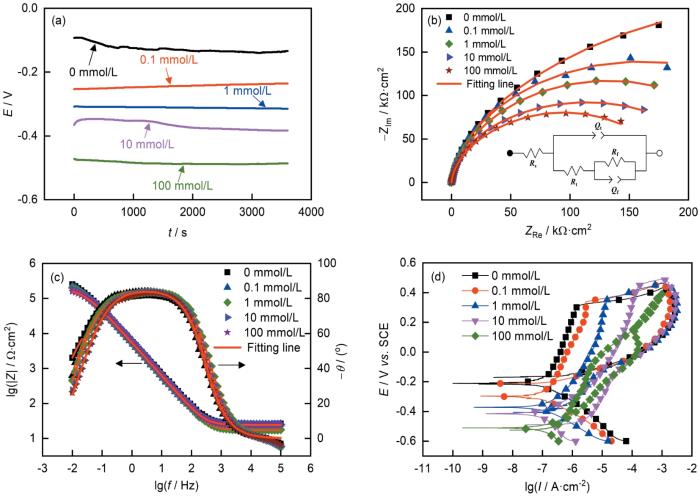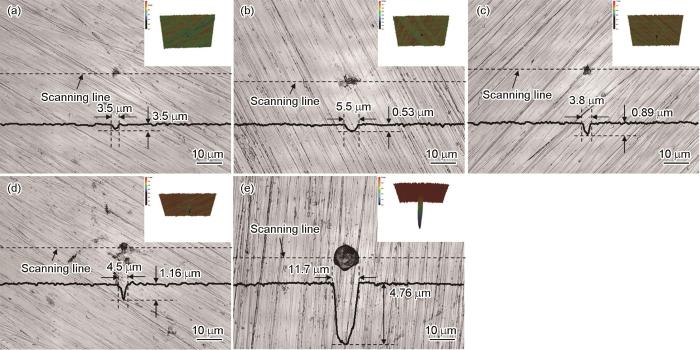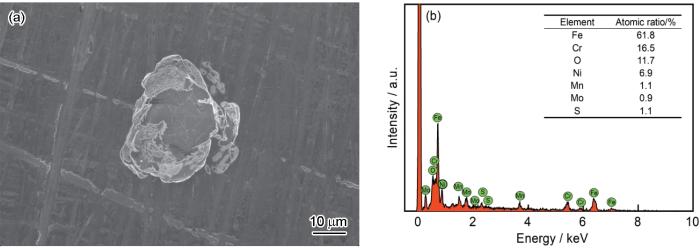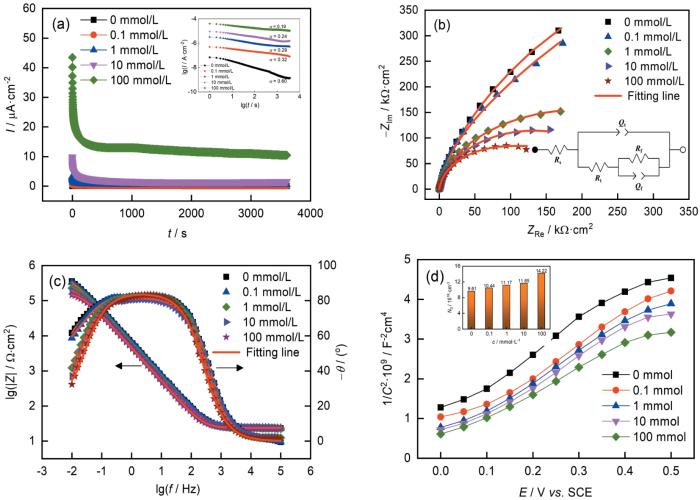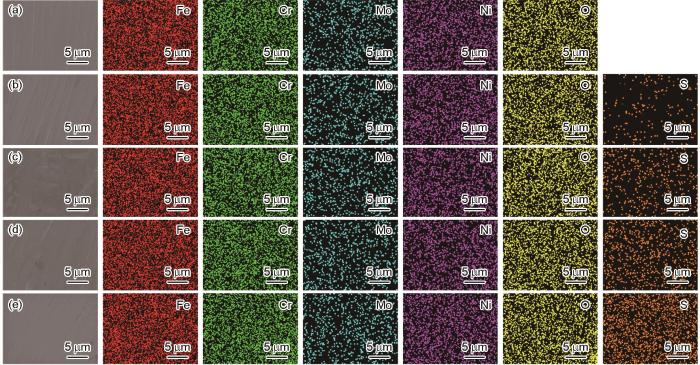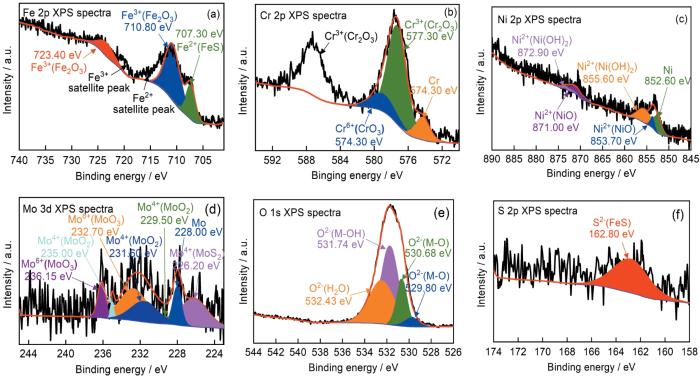目前,关于316L奥氏体不锈钢在海水环境中的耐腐蚀性能得到了大量研究,主要集中在海水温度[3,4]、静水压力[3,5]、海水浓度[6,7]和海洋微生物附着[8,9]等方面;关于Cl-和S2-对316L奥氏体不锈钢耐腐蚀性能的研究主要以油气田污水为研究背景[10~12]。张龙华等[10]研究了S2-浓度对316L奥氏体不锈钢在油气田污水中的耐腐蚀性能。结果表明:在Cl-存在的环境下,S2-对316L奥氏体不锈钢具有加速腐蚀的作用,S2-浓度越高,腐蚀倾向性越大,腐蚀电流密度越大,钝化膜中出现FeS是导致耐腐蚀性能下降的主要原因。周霄骋等[11]研究了Cl-和S2-对316L奥氏体不锈钢应力腐蚀的影响。结果表明:316L奥氏体不锈钢在含Cl-和S2-的环境中存在应力腐蚀敏感性,Cl-和S2-在腐蚀过程中存在竞争作用,出现耐腐蚀性能极值。张文丽等[13]研究了油气田污水温度对316L奥氏体不锈钢耐腐蚀性能的影响。结果表明:油气田污水温度升高,点蚀敏感性增加,点蚀击穿电位降低,并利用点缺陷模型结合竞争吸附理论和钝化膜/溶液界面处阳离子空位生成机理揭示了腐蚀变化规律。关于316L奥氏体不锈钢在含S2-的海水中的耐腐蚀性能方面,Gudic等[14]研究了海水温度和S2-浓度对316L奥氏体不锈钢耐腐蚀性能的影响。结果表明:温度升高和S2-浓度增大均降低316L奥氏体不锈钢的耐腐蚀性能,点蚀坑的数量、直径和深度均增大,S2-浓度对耐腐蚀性能的影响程度高于海水温度。因此,综合相关研究现状,关于316L奥氏体不锈钢在海水环境中和油气田污水环境中的研究已出现大量报道,然而油气田污水中的S2-和Cl-浓度与近海S2-污染海水相差较大,参考借鉴意义较小。
随着316L奥氏体不锈钢在近海跨海桥梁和油气输送管道的应用愈加广泛,关于316L奥氏体不锈钢在近海S2-污染海水中的腐蚀行为和钝化行为需要进一步深入研究,阐明腐蚀钝化行为变化规律的内在机理,为实际应用建造提供腐蚀数据和理论支持。因此,本文采用电化学测试技术、扫描电子显微镜(SEM)、能谱仪(EDS)、X射线光电子能谱仪(XPS)和激光共聚焦扫描显微镜(CLSM)等手段,系统地研究316L奥氏体不锈钢在不同S2-浓度下的腐蚀行为和钝化行为,分析钝化膜组成成分,揭示S2-和Cl-对316L奥氏体不锈钢的腐蚀钝化行为的协同作用。
1 实验方法
实验材料为316L奥氏体不锈钢板材,电化学试样规格为10 mm × 10 mm × 2 mm。使用Spectro型直读光谱仪测定化学成分(质量分数,%),主要包括:C 0.028、Cr 16.25、Mo 2.14、Ni 9.95、Mn 1.35、Si 0.49、P 0.037、S 0.012和Fe Bal.。实验试剂均为分析纯试剂,实验前未经过任何纯化处理。模拟人工海水按照ASTM D 1141-1998《替代海水制备的标准实施规程》配置,利用0.1 mol/L的NaOH水溶液调整pH为8.2。通常,天然干净海水中的硫化物浓度约为2~7 μg/L,而在近海海水环境中的硫化物浓度高达50 μg/L[15,16]。因此,本文实验溶液为含有不同摩尔浓度S2-(Na2S)的人工海水,其中,S2-的摩尔浓度分别为0、0.1、1、10和100 mmol/L,NaCl 24.53 g/L,MgCl2 5.20 g/L,Na2SO4 4.09 g/L,CaCl2 1.16 g/L,KCl 0.695 g/L,NaHCO3 0.201 g/L,KBr 0.101 g/L,氧含量7.2 mg/L。
对电化学试样进行焊线、封装、打磨和抛光后,在无水乙醇和去离子水中超声清洗10 min,吹干备用。使用HLC-1008型恒温槽控制实验溶液温度为(25 ± 1)℃。电化学测试在CS310M型电化学工作站进行,采用三电极体系,其中,电化学试样为工作电极,铂片电极为对电极,饱和甘汞电极为参比电极。本文所指的电极电位均为相对于饱和甘汞电极。首先进行开路电位(OCP)测试,测试时间为3600 s,以确保测试体系达到稳态。电化学阻抗谱(EIS)测试在OCP下进行,扫描频率范围为105~10-2 Hz,扰动振幅为10 mV。循环动极化曲线初始电位为-0.6 V,扫描速率为0.167 mV/s,阳极极化电流密度达到1 mA/cm2时换向扫描,反向扫描电流小于0时停止。恒电位极化前,工作电极在-1 V下阴极极化5 min,去除工作电极在空气中自然形成的钝化膜。恒电位极化的电位为0 V,极化时间为3600 s。恒电位极化完毕后,将电化学试样置于模拟人工海水中依次进行OCP、EIS和Mott-Schottky曲线测试,Mott-Schottky曲线扫描电位范围为0~0.5 V,扫描速率50 mV/s,测试频率为1 kHz。
循环极化实验完毕后,使用无水乙醇和去离子水对电化学试样表面超声清洗10 min并吹干,使用VK-X250型CLSM对腐蚀形貌进行观察和扫描。使用ZEISS Gemini 300型SEM观察恒电位极化后的表面形貌并测定化学成分。使用Thermo Kalpha型XPS对恒电位极化后的电化学试样表面进行化学成分价态测定,X射线为Mg Kα射线,加速电压为12 kV,工作电流为20 mA,以污染碳C 1s电子结合能(284.80 eV)校正光谱峰位。
2 结果与讨论
2.1 不同S2-浓度人工海水中的耐腐蚀性能
图1为316L奥氏体不锈钢在不同S2-浓度的人工海水中的OCP、EIS和循环动电位极化曲线。从图1a可以看出,随着S2-浓度的增大,OCP负移,这表明S2-对316L奥氏体不锈钢具有增大腐蚀倾向性的作用。从图1b可以看出,不同S2-浓度的人工海水中的Nyquist图均为第一象限内的容抗弧,无感抗L和Warbug阻抗,这表明测试体系只受电化学活化控制。随着S2-浓度的增大,容抗弧半径减小,这表明S2-对316L奥氏体不锈钢的耐腐蚀性能具有损害作用。从图1c的相位角图可以看出,随着频率f的降低,相位角-θ先增大后减小,在10-1~102 Hz区间内,相位角-θ出现由两个峰叠加形成的宽峰,这表明测试体系存在两个时间常数τ。此外,随着S2-浓度的增大,低频区域的相位角-θ和模值|Z|降低,这表明S2-对316L奥氏体不锈钢钝化膜的屏蔽性能具有破坏作用。结合EIS和316L奥氏体不锈钢表面的物理结构,采用Rs(Qt(Rt(QfRf)))型等效电路进行拟合,如图1b插图所示,拟合参数如表1所示。其中,Rs为工作电极至参比电极之间的溶液电阻,Qt和Rt为双电层对应的常相位角元件和电荷转移电阻,Qf和Rf为钝化膜对应的常相位角元件和电荷转移电阻。常相位角元件Q用于替代非理想电容C,其阻抗表达式如
图1
图1
316L奥氏体不锈钢在不同S2-浓度人工海水中的OCP、Nyquist图、Bode图和循环动电位极化曲线
Fig.1
OCP (a), Nyquist plots (b), Bode plots (c) and cyclic potentiodynamic polarization curves (d) of 316L austenitic stainless steel in artificial seawater with different S2- concentrations
表1 不同S2-浓度人工海水中的EIS拟合参数
Table 1
S2- concentrations mmol·L-1 | Rs Ω·cm2 | Rt Ω·cm2 | Yt Ω-1·cm-2·s-n | nt | Rf Ω·cm2 | Yf Ω-1·cm-2·s-n | nf | χ2 |
|---|---|---|---|---|---|---|---|---|
| 0 | 25.68 | 3.01 × 105 | 3.02 × 10-5 | 0.93 | 1.86 × 105 | 7.81 × 10-5 | 0.86 | 1.2 × 10-3 |
| 0.1 | 25.34 | 2.33 × 105 | 3.36 × 10-5 | 0.95 | 8.18 × 104 | 8.82 × 10-5 | 0.93 | 1.5 × 10-3 |
| 1 | 25.76 | 1.80 × 105 | 3.79 × 10-5 | 0.95 | 5.69 × 104 | 9.67 × 10-5 | 0.92 | 2.0 × 10-3 |
| 10 | 24.82 | 1.72 × 105 | 4.11 × 10-5 | 0.94 | 4.38 × 104 | 1.13 × 10-4 | 0.79 | 1.7 × 10-3 |
| 100 | 24.32 | 1.39 × 105 | 4.22 × 10-5 | 0.86 | 3.53 × 104 | 1.22 × 10-4 | 0.86 | 1.5 × 10-3 |
从图1d可以看出,当S2-浓度小于100 mmol/L时,循环动电位极化曲线均存在明显的钝化区间,随着S2-浓度的增大,钝化区间线性斜率减小,维钝电流密度增大;当S2-浓度为100 mmol/L时,循环动电位极化曲线的钝化区间完全消失;这表明S2-影响316L奥氏体不锈钢的钝化过程,S2-可能参与或阻碍钝化膜生成过程,降低钝化膜的屏蔽性能,增大维钝电流密度直至钝化区间完全消失。此外,随着S2-浓度的增大,循环极化曲线的阴极曲线部分斜率增大,这表明S2-的增大抑制了阴极吸氧过程。随着S2-浓度的增大,反向扫描曲线与正向扫描曲线均相交形成滞后环,滞后环面积减小;当S2-浓度小于0.1 mmol/L时,反向扫描曲线与正向扫描曲线相交于阳极极化曲线区,当S2-浓度大于1 mmol/L时,反向扫描曲线与正向扫描曲线相交于阴极极化曲线区;这表明当S2-浓度小于0.1 mmol/L时,316L奥氏体不锈钢具有再钝化性能,当S2-浓度大于1 mmol/L时,316L奥氏体不锈钢的再钝化性能消失。
表2为316L奥氏体不锈钢在不同S2-浓度的人工海水中的循环极化曲线参数。可以看出,随着S2-浓度的增大,腐蚀电流密度Icorr增大,这表明S2-对316L奥氏体不锈钢具有加速腐蚀的作用。此外,随着S2-浓度的增大,自腐蚀电位Ecorr和再钝化电位Erp负移,点蚀击穿电位Eb正移,这表明S2-和Cl-存在竞争吸附现象。Ecorr、Eb、Erp和换向扫描电位Ers将电位区间分为3个区域,即I区(Ecorr~Erp)、Ⅱ区(Erp~Eb)和Ⅲ区(Eb~Ers),在I区,点蚀不能形核发展;在Ⅱ区,已形成的点蚀可继续生长,但不能形成新的点蚀;在Ⅲ区,点蚀可形核和生长[17]。I区和Ⅱ区电位范围越宽,钝化和再钝化性能越好,Ⅲ区电位范围越宽,钝化和再钝化性能越差。当S2-浓度小于0.1 mmol/L时,随着S2-浓度的增大,Ⅱ区电位范围略微增大,316L奥氏体不锈钢的再钝化性能略微提高;当S2-浓度大于0.1 mmol/L时,Ⅱ区电位范围消失,316L奥氏体不锈钢的再钝化性能完全消失。因此,循环极化曲线表明:S2-浓度对316L奥氏体不锈钢耐腐蚀性能具有不同的影响,当S2-浓度小于0.1 mmol/L时,S2-、Cl-和OH-竞争吸附,S2-对腐蚀的加速作用较小,当S2-浓度大于1 mmol/L时,S2-通过降低钝化和再钝化性能的形式加速腐蚀,加速腐蚀速率与S2-浓度为正相关关系,这与EIS分析结果一致。
表2 不同S2-浓度的人工海水中循环动电位极化曲线参数
Table 2
| S2- concentrations / mmol·L-1 | Icorr / μA·cm-2 | Ecorr / V | Eb / V | Erp / V | Eb-Erp / V |
|---|---|---|---|---|---|
| 0 | 0.115 | -0.199 | 0.310 | -0.163 | 0.473 |
| 0.1 | 0.128 | -0.298 | 0.331 | -0.169 | 0.500 |
| 1 | 0.161 | -0.372 | 0.358 | - | - |
| 10 | 0.194 | -0.426 | 0.446 | - | - |
| 100 | 0.250 | -0.527 | - | - | - |
图2为316L奥氏体不锈钢在不同S2-浓度的人工海水中循环动电位极化后腐蚀形貌的CLSM图。可以看出,不同S2-浓度的人工海水中的腐蚀形貌均为典型的点蚀形貌,点蚀孔周围存在花边盖形貌。随着S2-浓度的增大,点蚀孔径和深度逐渐增大,点蚀类型从窄浅型转变为宽深型。对点蚀形貌进行扫描和统计,随着S2-浓度的增大,点蚀孔直径从3.5 μm增大至11.7 μm,点蚀孔深度从0.35 μm增大至4.78 μm。316L奥氏体不锈钢在不同S2-浓度人工海水中的点蚀类型为点蚀,且S2-浓度越大,点蚀直径和深度越大,S2-对点蚀具有加速作用。
图2
图2
不同S2-浓度的人工海水中循环极化后腐蚀形貌的CLSM图
Fig.2
CLSM surface images of 316L austenitic stainless steel after cyclic potentiodynamic polarization in artificial seawater with different S2- concentrations: (a) 0 mmol/L, (b) 0.1 mmol/L, (c) 1 mmol/L, (d) 10 mmol/L, (e) 100 mmol/L
图3
图3
含100 mmol/L S2-的人工海水中循环动电位极化后点蚀形貌和点扫描
Fig.3
Pitting morphology (a) and EDS result (b) of 316L austenitic stainless steel after cyclic potentiodynamic polarization in artificial seawater with 100 mmol/L S2-
2.2 不同S2- 浓度人工海水中的钝化性能
图4为316L奥氏体不锈钢在不同S2-浓度的人工海水中恒电位极化的I-t曲线、EIS、Mott-Schottky曲线和载流子密度ND。从图4a可以看出,不同S2-浓度的人工海水中恒电位极化的I-t曲线均分为两个部分,即随极化时间t的延长,电流密度I快速下降和缓慢下降两个阶段。其中,I快速下降阶段对应于双电层的快速放电过程,而I缓慢下降阶段对应于钝化膜的持续生成过程。随着S2-浓度的增大,恒电位极化过程的I增大,这表明恒电位极化生成的钝化膜屏蔽性能降低。316L奥氏体不锈钢在阳极极化过程中,暂态电流I和极化时间t符合对数衰减规律,如
图4
图4
不同S2-浓度人工海水中恒电位极化I-t曲线和恒电位极化后在人工海水中的Nyquist图、Bode图、Mott-Schottky曲线和施主浓度ND
Fig.4
I-t curves of potentiostatic polarization for 316L austenitic stainless steel in artificial seawater with different S2- concentrations (a), and Nyquist plots (b), Bode plots (c), Mott-Schottky curves and donor concentration ND (d) in artificial seawater after potentiostatic polarization
表3 在不同S2-浓度人工海水中恒电位极化后在人工海水中的EIS拟合参数
Table 3
S2- concentrations mmol·L-1 | Rs Ω·cm2 | Rt Ω·cm2 | Yt Ω-1·cm-2·s-n | nt | Rf Ω·cm2 | Yf Ω-1·cm-2·s-n | nf | χ2 |
|---|---|---|---|---|---|---|---|---|
| 0 | 23.79 | 5.00 × 105 | 2.80 × 10-5 | 0.94 | 7.69 × 106 | 1.46 × 10-6 | 0.83 | 8.0 × 10-4 |
| 0.1 | 23.80 | 4.65 × 105 | 3.00 × 10-5 | 0.93 | 6.94 × 106 | 2.88 × 10-6 | 0.85 | 9.0 × 10-4 |
| 1 | 23.65 | 2.77 × 105 | 3.37 × 10-5 | 0.93 | 3.55 × 106 | 1.16 × 10-6 | 0.93 | 1.2 × 10-3 |
| 10 | 23.88 | 2.59 × 105 | 3.80 × 10-5 | 0.92 | 2.67 × 106 | 1.88 × 10-5 | 0.77 | 1.4 × 10-3 |
| 100 | 23.67 | 1.76 × 105 | 3.91 × 10-5 | 0.94 | 9.34 × 105 | 3.67 × 10-5 | 0.92 | 2.0 × 10-3 |
图5
图5
不同S2-浓度的人工海水中恒电位极化后的微观形貌和面扫描
Fig.5
SEM images and EDS elemental mappings of 316L austenitic stainless steel after potentiostatic polarization in artificial seawater with different S2- concentrations: (a) 0 mmol/L, (b) 0.1 mmol/L, (c) 1 mmol/L, (d) 10 mmol/L, (e) 100 mmol/L
图6为316L奥氏体不锈钢在100 mmol/L的S2-浓度人工海水中恒电位极化后钝化膜的XPS谱,并结合XPS标准谱图进行分峰拟合。从图6a可以看出,Fe的精细谱分峰拟合后,结合能为707.30 eV的衍射峰对应于FeS中的Fe2+,而结合能为710.80和723.40 eV的衍射峰对应于Fe2O3中的Fe3+,这表明S2-参与钝化膜生成过程并形成FeS的掺杂。从图6b可以看出,Cr的精细谱分峰拟合后出现Cr、Cr3+和Cr6+的特征衍射峰,其中结合能为574.30 eV的衍射峰对应于钝化膜的Cr单质,577.30和579.00 eV的衍射峰分别对应于Cr2O3和CrO3中的Cr3+和Cr6+。从图6c可以看出,结合能为852.60 eV的衍射峰对应于Ni单质,结合能为853.70和871.00 eV的衍射峰对应于NiO中的Ni2+,结合能为855.60和872.90 eV的衍射峰对应于Ni(OH)2中的Ni2+。从图6d可以看出,Mo的精细谱分峰拟合后出现Mo、Mo4+和Mo6+的特征衍射峰,其中,结合能为228.00 eV的衍射峰对应于钝化膜中的Mo单质,结合能为229.50、231.60和235.00 eV的衍射峰分别对应于MoO2中的Mo4+,结合能为232.70 和236.15 eV的衍射峰分别对应于MoO3中的Mo6+,结合能为226.20 eV的衍射峰对应于MoS2中的Mo4+,这表明S2-参与钝化膜形成过程并形成MoS2的掺杂。从图6e可以看出,结合能为529.80和530.68 eV的衍射峰分别对应于金属氧化物M-O中的O2-,结合能为531.74 eV的衍射峰对应于金属氢氧化物M-OH中的O2-,而结合能为532.43 eV的衍射峰对应于H2O中的O2-。从图6f可以看出,S的精细谱中只有1个衍射峰,结合能为162.80 eV的衍射峰对应于S2-。因此,XPS的实验结果表明:316L奥氏体不锈钢在100 mmol/L的S2-浓度人工海水中恒电位极化生成的钝化膜的主要成分有Fe2O3、FeO、Cr2O3、CrO3、MoO2、MoO3、Ni(OH)2和NiO,这与大多数的不锈钢钝化膜的主要成分基本一致[23~25],但还存在FeS和MoS2,FeS和MoS2对钝化膜形成掺杂,这与EDS和EIS拟合结果对应一致。
图6
图6
在含100 mmol/L S2-的人工海水中恒电位极化后钝化膜的XPS谱
Fig.6
XPS spectra of passivating film formed on 316L austenitic stainless steel after potentiostatic polarization in artificial seawater with 100 mmol/L S2-: (a) Fe 2p, (b) Cr 2p, (c) Ni 2p, (d) Mo 3d, (e) O 1s, (f) S 2p
2.3 讨论
以上实验结果表明:在人工海水中添加S2-会增加316L奥氏体不锈钢腐蚀倾向性并加快腐蚀速率。S2-具有强碱性,其水解后溶液呈强碱性,如
3 结论
(1) 316L奥氏体不锈钢在含S2-的人工海水中的腐蚀形式是点蚀,随着S2-浓度的增大,OCP负移0.352 V,自腐蚀电位Ecorr负移0.328 V,再钝化电位Ep均负移,腐蚀电流密度Icorr增大约1倍,点蚀孔直径和深度增大,耐腐蚀性能下降;当S2-浓度大于0.1 mmol/L时,316L奥氏体不锈钢失去再钝化性能,当S2-浓度大于100 mmol/L时,316L奥氏体不锈钢失去钝化性能。
(2) S2-和Cl-对316L奥氏体不锈钢的耐腐蚀性能具有协同破坏作用,S2-通过水解提高溶液pH,S2-和OH-竞争吸附阻碍钝化膜生成,降低钝化膜生成速率,并且S2-参与钝化过程形成FeS和MoS2,钝化膜掺杂程度提高,载流子密度ND增大,钝化膜屏蔽性能降低。
参考文献
Adaptability evaluation of 316L stainless steel based on pitting corrosion in acid gas field
[J].
基于点蚀的316L不锈钢在酸性气田环境中的适应性评价
[J].
Corrosion behavior of materials used for surface gathering and transportation pipeline in an oilfield
[J].
某油田地面集输管道用材腐蚀行为研究
[J].模拟油田现场腐蚀环境,利用高温高压实验设备辅以失重法研究了某油田地面集输管道正在使用中的管材20G钢、L245钢、5Cr钢、316L不锈钢和板材16Mn钢在不同温度和CO<sub>2</sub>分压下的腐蚀行为,并采用扫描电镜 (SEM)、电子能谱 (EDS) 和X射线衍射 (XRD) 等方法对腐蚀产物的形貌及成分进行分析。结果表明:20G钢、L245钢、5Cr钢、16Mn钢和316L不锈钢均在温度一定的情况下,随CO<sub>2</sub>分压的增大,平均腐蚀速率先增大后减小;在CO<sub>2</sub>分压一定的情况下,平均腐蚀速率随温度的升高先增大后减小。在温度为80 ℃,CO<sub>2</sub>分压为0.5 MPa时,均达到最大平均腐蚀速率。20G钢、L245钢、5Cr钢和16Mn钢的腐蚀形貌为不均匀的全面腐蚀,腐蚀产物主要为FeCO<sub>3</sub>,316L不锈钢由于在腐蚀介质中发生钝化,腐蚀形貌为轻微的点蚀。
Influence of temperature and hydrostatic pressure on the galvanic corrosion between 90/10 Cu-Ni and AISI 316L stainless steel
[J].
Electrochemical corrosion characteristics of type 316L stainless steel in hot concentrated seawater
[J].
Effect of deep ocean on critical pitting temperature of 316L stainless steel
[D].
深海环境对316L不锈钢临界点蚀温度的影响
[D].
Effect of seawater level on corrosion behavior of different alloys
[J].
Pitting resistance of anodic passive films formed on 316L stainless steel in the concentrated artificial seawater
[J].
Investigation of the crevice corrosion behavior of 316L stainless steel in sulfate-reducing bacteria-inoculated artificial seawater using the wire beam electrode
[J].
The corrosion of 316L stainless steel induced by methanocossus mariplaudis through indirect electron transfer in seawater
[J].
Corrosion behavior of 316L stainless steel in simulated oilfield wastewater
[J].
S2-对316L不锈钢在模拟油田污水中的腐蚀行为影响研究
[J].研究了不同浓度S<sup>2-</sup>对316L不锈钢在模拟油田污水中的腐蚀行为的影响。通过电化学测试和XPS等方法分析了S<sup>2-</sup>对316L不锈钢在油田污水中电化学及表面膜层性能的影响。结果表明,S<sup>2-</sup>的存在加速316L不锈钢的腐蚀,并且随着S<sup>2-</sup>浓度的升高,腐蚀倾向增大,耐蚀性下降。XPS结果显示,316L不锈钢钝化膜中出现了FeS,阻碍了钝化膜的进一步生长,外层钝化膜疏松,保护性降低。
Influence of Cl- concentration on stress corrosion cracking behavior of 316L stainless steel in alkaline NaCl/Na2S solution
[J].
Cl-浓度对316L不锈钢在碱性NaCl/Na2S溶液中SCC行为的影响
[J].采用动电位极化曲线、EIS、SSRT和U形弯试样浸泡实验研究了Cl<sup>-</sup>浓度对316L不锈钢在碱性NaCl/Na<sub>2</sub>S溶液中SCC行为的影响。结果表明,316L不锈钢在碱性NaCl/Na<sub>2</sub>S环境中表现出一定的应力腐蚀敏感性,Cl<sup>-</sup>与S<sup>2-</sup>对316L不锈钢腐蚀过程存在竞争作用,导致电化学阻抗出现极值。随着Cl<sup>-</sup>浓度增大,氢致韧性作用能够在一定程度上增大316L不锈钢的延伸率,降低塑性损失,但对其断裂应力影响不大。
Effect of Cl- on stress corrosion of cold deformed 316L austenitic stainless steel in H2S environment
[J].
Cl-对冷变形316L奥氏体不锈钢在H2S环境下应力腐蚀的影响
[J].
Effect of temperature on pitting corrosion behavior of 316L stainless steel in oilfield wastewater
[J].
温度对316L不锈钢在油田污水中点蚀行为的影响研究
[J].通过动电位极化以及SEM分析对316L不锈钢在不同温度油田污水中的腐蚀行为进行了研究,同时利用点缺陷模型 (PDM) 解释了不锈钢的点蚀行为。结果表明,随着温度的升高,点蚀敏感性增加,点蚀电位降低。通过PDM分析了点蚀电位与电势扫描速率平方根在不同温度下的实验结果。PDM结合竞争性吸附理论和在钝化膜/溶液界面处阳离子空位生成机理成功地解释了本文的结果。
Corrosion behavior of stainless steel in seawater in the presence of sulfide
[J].The effect of temperature (from 288 to 308 K) and concentration of sulfide ions (up to 40 ppm) on the corrosion behavior of AISI 304L and AISI 316L stainless steels in seawater was studied with measurements of open-circuit potential, linear and potentiodynamic polarization, and electrochemical impedance spectroscopy. An increase in temperature and pollutant concentration negatively affects the corrosion stability of stainless steels at the open circuit (the resistance, compactness, and thickness of the surface layer decrease and the corrosion current increases), in the passive region (the passivation current increases, the depassivation potential decreases, and the passive potential region narrows), and in the transpassive potential region (the rate of metal dissolution increases). The occurrence of pitting corrosion on the surface of the samples was confirmed with optical microscopy and a non-contact 3D profilometer. A few large pits (depth 80–100 μm and width 100 μm) were formed on the surface of AISI 304L steel, while several smaller pits (depth 40–50 μm and width 50 μm) were formed on the surface of AISI 316L steel. With increasing temperature and sulfide ion concentration, the width, depth, and density of the pits increased on both steel samples. In the studied temperature and concentration range of sulfide ions, the AISI 316L steels exhibited higher corrosion resistance. Overall, the influence of sulfide ions on steel corrosion was more pronounced than the influence of temperature.
Corrosion behavior of Cu-Ti alloy in simulated S2- contaminated seawater
[J].
Cu-Ti合金在模拟S2-污染海水中的腐蚀行为
[J].
Evaluation of corrosion and erosion-corrosion resistances of mild steel in sulfide-containing NaCl aerated solutions
[J].
Current application and development trend in electrochemical measurement methods for the corrosion study of stainless steels
[J].
电化学方法在不锈钢腐蚀研究中的应用现状及发展趋势
[J].
Development of a scratch test in an autoclave for the measurement of repassivation kinetics of stainless steel in high temperature high pressure water
[J].
Development of a scratch electrode system in high temperature high pressure water
[J].
Effects of alloying elements, Cr, Mo and N on repassivation characteristics of stainless steels using the abrading electrode technique
[J].
Electrochemical behaviour of high nitrogen stainless steel in acidic solutions
[J].
Effect of temperature on passive film formation of UNS N08031 Cr-Ni alloy in phosphoric acid contaminated with different aggressive anions
[J].
Investigation on the composition and semi-conductive property of the passive film on 22Cr duplex stainless steel
[J].The semi-conductive performance of the passive film formed on 22Cr duplex stainless steel in bicarbonate/carbonate buffer solution was investigated by Mott-Schottky analysis, and the factors, including formation potential, formation time, formation temperature and chloride ions, etc., which affect the film semi-conductive property, were also examined. The film compositions were analyzed by the X-ray photoelectron spectra (XPS). The results showed that the passive film formed on 22Cr duplex stainless steel in bicarbonate/carbonate buffer solution displayed an n-p semi-conductive character, and the donor density ND and the acceptor density NA decreased with increasing the formation potential, prolonging the formation time, decreasing the formation temperature, and decreasing the chloride ion concentration. In addition, the protective effect of the passive film on 22Cr alloy was enhanced with the variation of these factors. XPS analysis revealed that the passive film had a double-layer structure, i.e., the outer trivalent iron oxide, and the inner chromium oxide with a little content of divalent iron oxide.
22Cr双相不锈钢钝化膜组成及其半导体性能研究
[J].借助于Mott-Schottky方程分析了成膜电位、成膜时间、成膜温度以及氯离子等因素对22Cr双相不锈钢在碳酸氢钠/碳酸钠缓冲溶液中所成钝化膜半导体性能的影响, 同时借助于X射线光电子能谱(XPS)技术分析了所成钝化膜的组成. 结果表明: 22Cr双相不锈钢在碳酸氢钠/碳酸钠缓冲溶液中所成钝化膜呈n-p型半导体结构, 钝化膜内施主/受主密度随成膜电位增加、成膜时间延长、成膜温度降低、以及介质中氯离子浓度的降低而减小, 同时膜对基体保护作用随这些因素变化而增强. 钝化膜的XPS分析表明, 钝化膜呈现双层结构, 外层膜主要由三价铁的氧化物(Fe2O3)组成, 内层膜主要由三价铬氧化物(Cr2O3)以及少量二价铁氧化物(FeO)组成.
Corrosion resistance of 2507 duplex stainless steel in NaClO solution
[J].Electrochemical potentiodynamic reactivation (EPR), potentiodynamic polarization curve and electrochemical impedance spectroscopy (EIS) methods were applied to investigate the intergranular corrosion and the pitting corrosion behaviors of 2507 duplex stainless steel (SAF2507), and the composition of the passive film formed on the corrosive surface of SAF2507 was studied by using the X-ray photoelectron spectrometer (XPS) analysis. The results show that the reactivation rate (<em>R</em><sub>a</sub>) of SAF2507 is 0.68%, which exhibits good intergranular corrosion resistance. The results of potentiodynamic polarization curve, and EIS show that the surface of SAF2507 can engender passivation phenomenon after polarization, the passivation range is -0.5-0.6V, and the charge transfer resistance is 1.389×10<sup>4</sup>Ω·cm<sup>2</sup>, which shows better pitting corrosion resistance. XPS demonstrates that the composition of the passive film in 5g/L NaClO solution is mainly composed of oxides and hydrogen oxygen compounds of Cr and Fe. Meanwhile, the corrosion mechanism of SAF2507 was further explored.
2507双相不锈钢在NaClO溶液中的腐蚀性能
[J].




